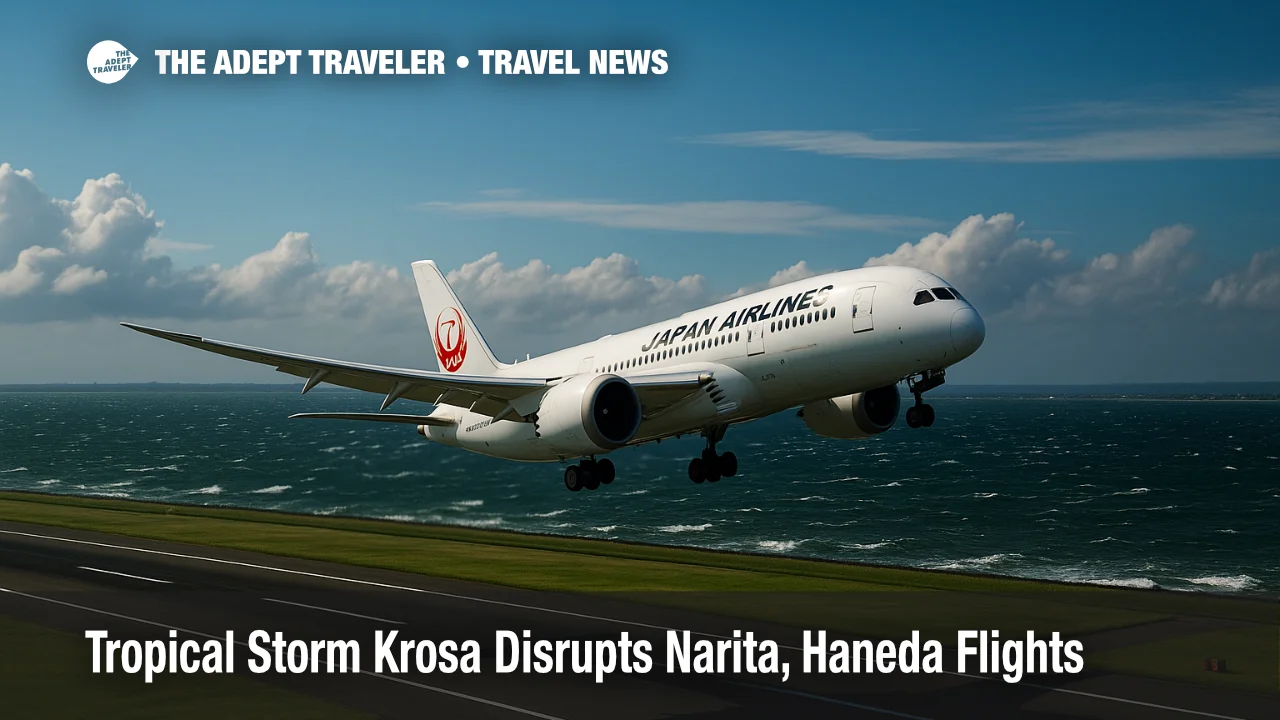Tropical Storm Krosa Disrupts Narita, Haneda Flights

Tropical Storm Krosa brushed past Japan's Kanto coastline early Sunday, kicking up white-capped seas and snarling air traffic at Tokyo's two international gateways. Narita International Airport (NRT) and Haneda Airport (HND) reported wave after wave of weather linked delays as airlines preemptively scrubbed some services and activated no fee change policies to keep stranded travelers moving.
Key Points
- Why it matters: Krosa is the ninth named Pacific storm this season and the first to target greater Tokyo's air corridor.
- Travel impact: Dozens of departures were delayed or canceled at Narita and Haneda, and carriers from ANA to WestJet issued fee free rebooking waivers.
- What's next: Forecast models show Krosa accelerating northeast by Monday, allowing flight schedules to normalize, but summer typhoon season runs through October.
Snapshot
Japan Meteorological Agency data at 9 a.m. local time placed Krosa 90 miles east-southeast of Choshi, packing sustained winds near 40 mph and a central pressure of 975 hPa. The agency warned of six meter waves along the Boso Peninsula and locally intense downpours of up to four inches through Monday morning. Airport arrival streams thinned as All Nippon Airways (ANA) flagged "possible disruption" on flights through August 3, and Japan Airlines (JAL) posted blanket delay notices for both Tokyo hubs. North American carriers, including Air Canada and WestJet, activated flexible travel advisories that cover Tokyo routes through August 2.
Background
Krosa spun up over warm Philippine Sea waters mid-week and followed a classic recurving track toward Japan's Pacific seaboard. While only a "severe tropical storm," its broad wind field overlapped one of the world's busiest air corridors at the start of Japan's Obon holiday travel rush. The Kanto coast, home to 45 million residents, last saw significant typhoon grade disruption in September 2023, when Typhoon Yun-yeung flooded rail lines for two days. Flood control upgrades since then have raised levees on the Tone and Arakawa Rivers, but forecasters still warn of localized landslides on the Izu Islands and Boso headlands.
Latest Developments
Storm Track and Timing
As of 3 p.m. Sunday, JMA projected Krosa to veer east-northeast, skimming past Chiba's Boso Peninsula overnight before racing toward the open Pacific. Peak onshore gusts of 50 mph are expected along eastern Chiba between 6 p.m. and midnight, with seas gradually subsiding after sunrise Monday. Maritime authorities directed the Port of Yokohama to impose a two-hour arrival hold for vessels over 20,000 GT, echoing similar restrictions at Kashima and Hitachinaka. Japan Rail East said limited express services south of Choshi could incur short suspensions if rainfall tops two inches per hour.
Airline Responses and Waivers
All Nippon Airways alerted passengers that "flights to / from Tokyo Narita and Tokyo Haneda may be affected from August 1 to 3," advising online rebooking. JAL's weather desk listed both airports among facilities likely to see cancellations through August 4. Foreign carriers followed suit: Air Canada, WestJet, Cathay Pacific, and China Airlines each published typhoon waivers covering travel to or from Tokyo through early next week. Most policies allow a one-time date change in the same cabin without additional fees or fare differentials. Travelers bound for connecting cruises or package tours should also confirm supplier policies on missed embarkations or hotel nights.
Analysis
Krosa's near miss underscores how even sub-typhoon systems can upend tightly choreographed summer travel. Tokyo's dual hub model often provides redundancy, yet both airports share the same coastal weather threshold: sustained crosswinds above 31 mph trigger runway change procedures that ripple into airborne holding delays. Carriers learned from Typhoon Faxai in 2019 and now pre-cancel select rotations instead of stacking arrivals. That strategy reduced tarmac congestion Sunday but shifted the burden onto customer-service hotlines, which quickly backed up. Travelers who booked via Japanese agencies fared better thanks to automatic itinerary pushes through the Amadeus system, highlighting the value of professional intermediaries. Rail links, especially the Narita Express and Keisei Skyliner, also face wind limits; savvy travelers kept Suica balances topped up in case of bus substitutions. Looking ahead, typhoon season's peak arrives in September, and Krosa's early-August timing offers a rehearsal for both travelers and suppliers to refine contingency plans.
Final Thoughts
With Krosa now sliding up the Pacific coast, Tokyo's flight gridlock should ease by Monday afternoon. Even so, the storm illustrates how quickly weather can hobble Asia's busiest air market. Keep mobile numbers updated in airline profiles, monitor JMA bulletins, and lean on travel insurance hotlines for real-time assistance. Preparedness today prevents panic tomorrow-and helps you stay one step ahead of the next tropical storm krosa.
Sources
- Tropical Cyclone Information - Japan Meteorological Agency
- Severe Tropical Storm Krosa Approaches Eastern Japan - The Japan Times
- Flight Information Weather Advisory - Japan Airlines
- ANA Flight Info Typhoon Notice - X
- Travel Advisory: Typhoon Krosa - WestJet
- Tropical Cyclone Krosa Advisory - Cathay Pacific
